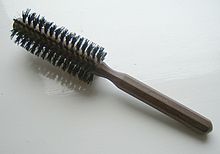
Back حزمة ليفية Arabic Fibrat Catalan Fibrovaný prostor Czech Faserbündel German Δέσμη ινών Greek Fibra fasko Esperanto Fibrado Spanish کلاف تاری Persian Fibré French Fibrato Italian

In mathematics, and particularly topology, a fiber bundle (Commonwealth English: fibre bundle) is a space that is locally a product space, but globally may have a different topological structure. Specifically, the similarity between a space and a product space is defined using a continuous surjective map, that in small regions of behaves just like a projection from corresponding regions of to The map called the projection or submersion of the bundle, is regarded as part of the structure of the bundle. The space is known as the total space of the fiber bundle, as the base space, and the fiber.
In the trivial case, is just and the map is just the projection from the product space to the first factor. This is called a trivial bundle. Examples of non-trivial fiber bundles include the Möbius strip and Klein bottle, as well as nontrivial covering spaces. Fiber bundles, such as the tangent bundle of a manifold and other more general vector bundles, play an important role in differential geometry and differential topology, as do principal bundles.
Mappings between total spaces of fiber bundles that "commute" with the projection maps are known as bundle maps, and the class of fiber bundles forms a category with respect to such mappings. A bundle map from the base space itself (with the identity mapping as projection) to is called a section of Fiber bundles can be specialized in a number of ways, the most common of which is requiring that the transition maps between the local trivial patches lie in a certain topological group, known as the structure group, acting on the fiber .










